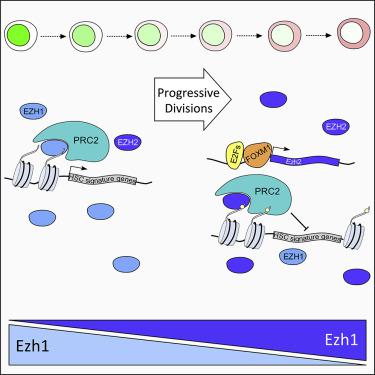Stem Cell Reports ( IF 5.9 ) Pub Date : 2020-04-02 , DOI: 10.1016/j.stemcr.2020.03.005 Jeffrey M Bernitz 1 , Katrina Rapp 2 , Michael G Daniel 1 , Dmitrii Shcherbinin 3 , Ye Yuan 1 , Andreia Gomes 4 , Avinash Waghray 1 , Ran Brosh 2 , Alexander Lachmann 5 , Avi Ma'ayan 5 , Dmitri Papatsenko 6 , Kateri A Moore 2

|
Hematopoietic stem cells (HSCs) exist in a dormant state and progressively lose regenerative potency as they undergo successive divisions. Why this functional decline occurs and how this information is encoded is unclear. To better understand how this information is stored, we performed RNA sequencing on HSC populations differing only in their divisional history. Comparative analysis revealed that genes upregulated with divisions are enriched for lineage genes and regulated by cell-cycle-associated transcription factors, suggesting that proliferation itself drives lineage priming. Downregulated genes are, however, associated with an HSC signature and targeted by the Polycomb Repressive Complex 2 (PRC2). The PRC2 catalytic subunits Ezh1 and Ezh2 promote and suppress the HSC state, respectively, and successive divisions cause a switch from Ezh1 to Ezh2 dominance. We propose that cell divisions drive lineage priming and Ezh2 accumulation, which represses HSC signature genes to consolidate information on divisional history into memory.
中文翻译:

分区历史记忆指导着原始造血谱系承诺的连续过程。
造血干细胞(HSC)处于休眠状态,并且随着它们的连续分裂而逐渐失去再生能力。为何会出现这种功能下降以及如何编码此信息尚不清楚。为了更好地了解此信息的存储方式,我们对仅在其分裂史上有所不同的HSC群体进行了RNA测序。比较分析显示,由分裂上调的基因富含谱系基因,并受细胞周期相关转录因子调控,表明增殖本身驱动谱系启动。但是,下调的基因与HSC签名相关,并被Polycomb Repressive Complex 2(PRC2)靶向。PRC2催化亚基Ezh1和Ezh2分别促进和抑制HSC状态,并且连续的划分导致从Ezh1到Ezh2优势的切换。我们建议细胞分裂驱动沿袭启动和Ezh2积累,这抑制HSC签名基因,以巩固分裂历史上的信息整合到内存中。



























 京公网安备 11010802027423号
京公网安备 11010802027423号